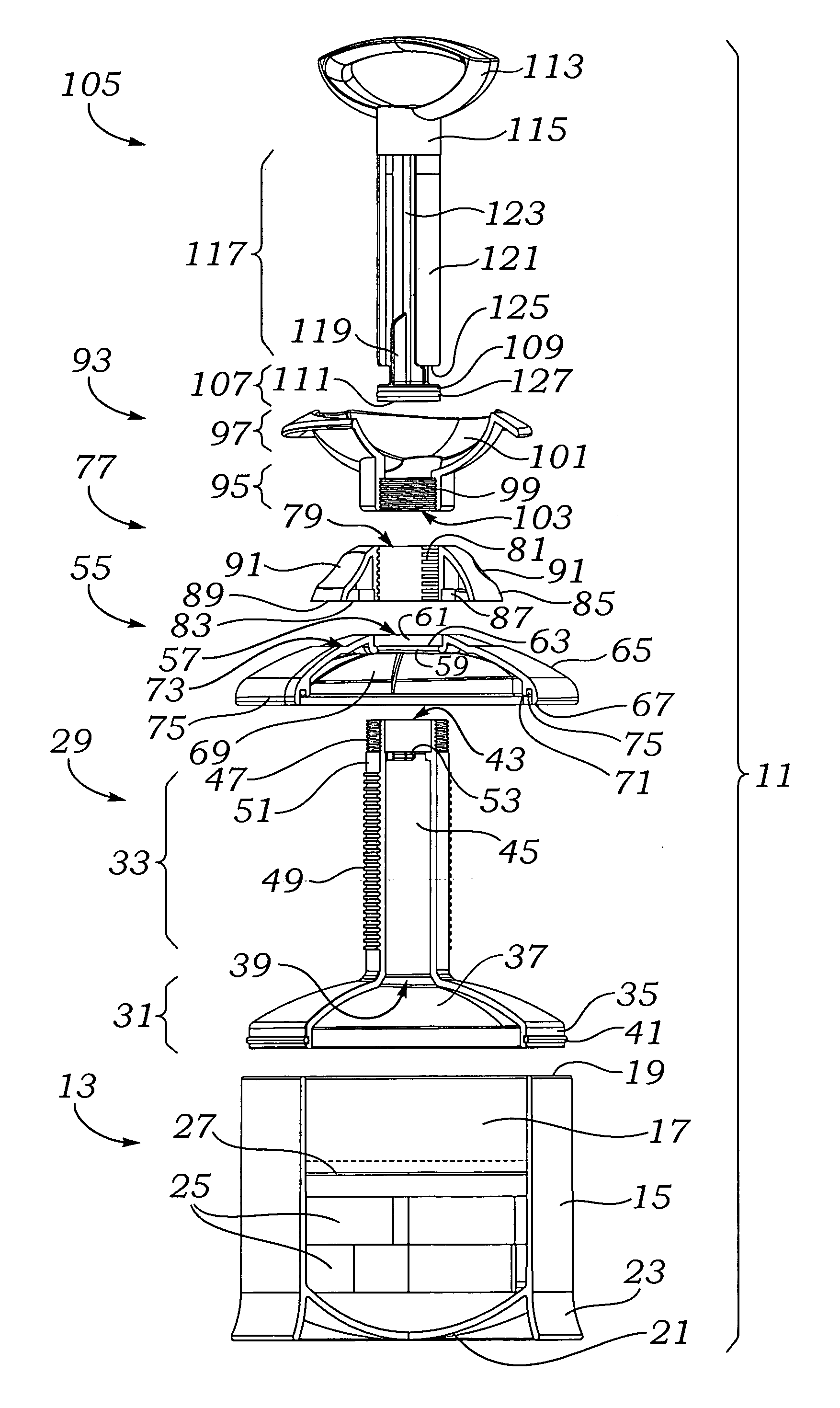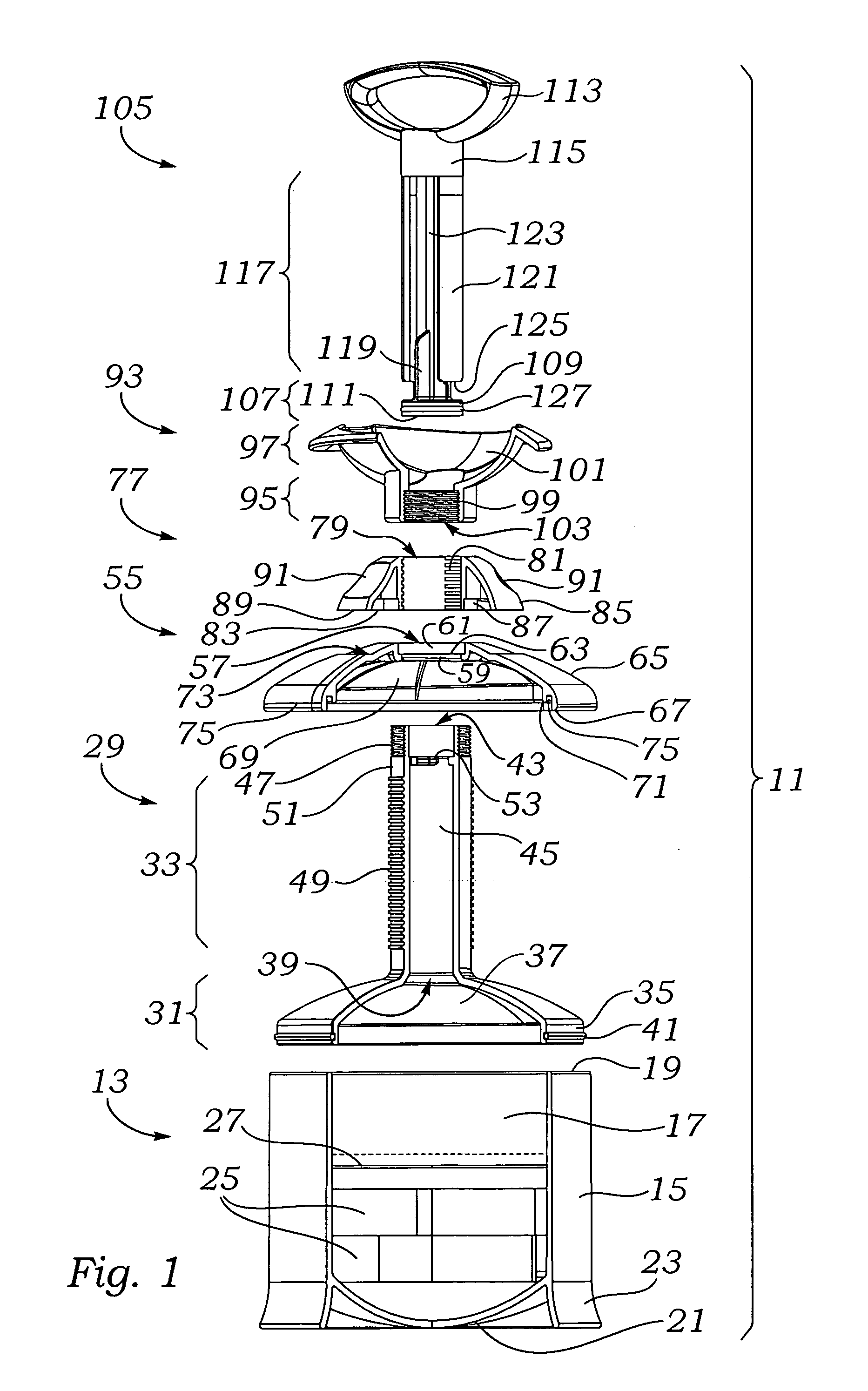Vacuum marination device
a marination device and vacuum technology, applied in the field of vacuum marination devices, can solve the problems of robbed food of its freshness and color, insufficient marination for 48 hours, and time-consuming marinade preparation, and achieve the effects of short time, minimal effort, and vacuum
- Summary
- Abstract
- Description
- Claims
- Application Information
AI Technical Summary
Benefits of technology
Problems solved by technology
Method used
Image
Examples
first embodiment
[0024]The description of the vacuum marination device of the present invention is best described with reference first to FIG. 1, which is an exploded cutaway view of the vacuum marination device 11 illustrating a container 13 with a side wall 15 having an inner surface 17, a top rim 19, and a bottom wall 21. Side wall 15 extends beyond bottom wall 21 to form a flange 23 on which container 13 rests. Container 13 is illustrated as oval in FIG. 1, but may be one of any number of shapes, such as round, square, or rectangular. Container 13 is illustrated as containing foodstuff 25 and a liquid marinade 27 covering foodstuff 25. Bottom wall 21 of container 13 is concave to allow foodstuff 25 to immerse within the liquid marinade 27 as much as possible and to resist deformation due to the pressure from the surrounding atmosphere, which is experienced when the pressure in the container 13 is lowered.
[0025]Illustrated directly above container 13 is an annular plunger member 29 forming a dome...
second embodiment
[0046]FIG. 4 is a cross-sectional view of the vacuum marination device 131 of the present invention and illustrates a container 133 with a top rim 135. FIG. 4 further illustrates a plunger 137 with a top surface 139 and a bottom surface 141. Plunger 137 has an air-out valve 143 extending through plunger 137 off-center which will allow air in the container 133 to easily escape when plunger 137 is lowered as the air-out valve 143 is located at the highest point of plunger 137. The escape of air can be even more complete if the container 133 is tilted during this process.
[0047]The air-out valve 143 is positioned off-center so that, as the plunger 137 is advanced into container 133, a user can quickly detect any marinade back flow through air-out valve 143, a ready indicator for moving to the step of activating the vacuum. Plunger 137 has an air-in valve 145 at its center connected to the threaded end nut or end cap 173 by a threaded shaft 146 running through a duct 147 in a threaded an...
third embodiment
[0050]FIG. 5 is a cutaway view of the vacuum marination device 175 which illustrates a container 177 with a top rim 179, side wall 181, and bottom wall 183. Bottom wall 183 is concave to allow marinade (not illustrated in FIG. 5) to reach more surface area of any foodstuff in container 177 (not illustrated in FIG. 5) and resist deformation due to the pressure experienced when the pressure in the container is lowered. Side wall 181 extends beyond bottom wall 183 to form a flange 185 on which container 177 rests. Container 177 can be extended to accommodate large volumes of food and marinade (not illustrated in FIG. 5) using intermediate stacking sections 187 of varying height.
[0051]Intermediate stacking sections 187 comprise a cylindrical wall 189 with a bottom rim 191, which forms a channel 193, and top rim 195. It is understood that channel 193 could be replaced by an inside groove, an outside groove, or other structure, and that the choice of structure may depend upon the material...
PUM
 Login to View More
Login to View More Abstract
Description
Claims
Application Information
 Login to View More
Login to View More - R&D
- Intellectual Property
- Life Sciences
- Materials
- Tech Scout
- Unparalleled Data Quality
- Higher Quality Content
- 60% Fewer Hallucinations
Browse by: Latest US Patents, China's latest patents, Technical Efficacy Thesaurus, Application Domain, Technology Topic, Popular Technical Reports.
© 2025 PatSnap. All rights reserved.Legal|Privacy policy|Modern Slavery Act Transparency Statement|Sitemap|About US| Contact US: help@patsnap.com



